F-35 "Lightning II" Joint Strike Fighter (JSF) Integration for Special Operations
06/16/2004
UPDATED 25 April 2008
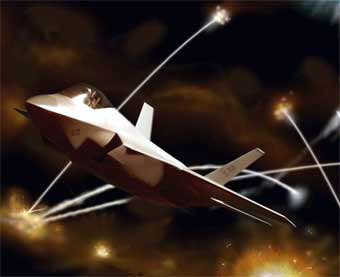
Click here to start
 www.youtube.com/watch?v=xTSRbXTh-_A
www.youtube.com/watch?v=xTSRbXTh-_A
Can the U.S. Navy control the skies and seas anymore? What could we do if we spent the $5 BILLION from a large aircraft carrier on more efficient means?
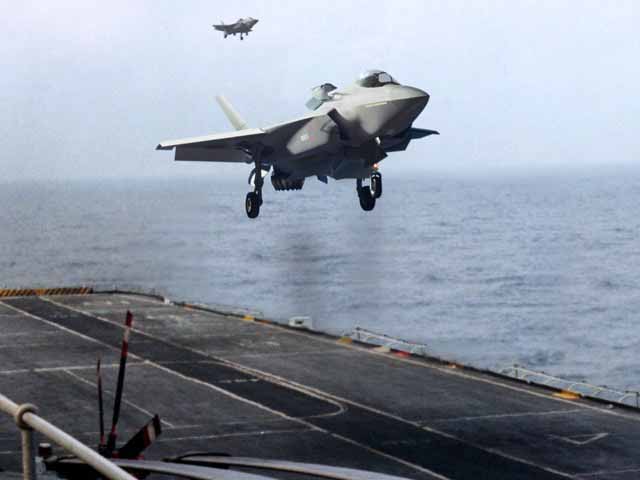
Watching the History Channel's recent secret airplanes of the allies and Japanese in WW2 stimulates a lot of new ideas we can use today. WW2 was filled with can-do men compared to today's can't-do bureaucrats and visionless Admirals, Generals and corporate CEOs. Fortunately for us Winston Churchill was on our side.
Fleet Air Defense without aircraft carriers: Hurricat & F-35
In the July 2004 U.S. Army/Air Force Aviation Journal, we made the case for the jet seaplane patrol bomber proven effective by the allies in WW2 by the PBY Catalina, which the History Channel show reveals a Navy crew was flying when they discovered a crashed Japanese Zero fighter in the Aleutians that led to our learning its aerodynamic secrets. During WW2, the U.S. Navy was able to rescue 444 men from certain death in large seaplanes like the Catalina, PBM Mariner and Mars, as well as defeat German and Japanese submarines, sink ships and transports thousands of men and millions of pounds of equipment through the highly efficient naval air transport service (NATS).
We point out in our Jet seaplane power point slides that the German FW200 Condor 4-engined patrol plane (a land based converted airliner) was very effective for the Germans at sinking our merchant ships in the Atlantic and vectoring U-boat submarines. While not as ideal as our PBY/PBMs which could be sea-based, Winston Churchill was desperate to stop these planes whom he called the "Scourge of the Atlantic" which in one month alone has sunk 1,000,000 tons of shipping. What we did to counter the Condors set us apart from the Japanese who were starved into submission by our PBY Black Cats, PBM Mariners and Gato-class long range patrol submarines. Fortunately for us the Japanese were more prepared to fight the Russians deep inland on the Euroasian continent and only had about 100 Emily 4-engined seaplane patrol bomber aircraft. Churchill, the brilliant genius who created the tracked tank in WWI was a classic non-linear thinker and saw that battleships routinely launch spotter seaplanes off short catapults realized that the same technique could be applied to merchant ships to get a Hurricane fighter plane in the air to shoot down the Condors. Research showed a Hurricane on a launch rail sent down by a rocket motor would work, and before long in 1942 a "Hurricat" had shot down a Condor, ending the air recon/attack 3D compliment to their U-Boat's 2D maneuver & attack.
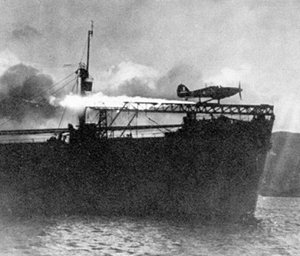
What's interesting is that after the Hurricane fighter was done warding off a Condor, it couldn't land safely in the water as a landplane without floats, skis or boat hull shape and had to violently ditch, putting the pilot's life in severe jeopardy in the frigid North Atlantic, but these were courageous can-do men. Decades later, the Sea Harrier and Royal Air Force Harriers saved the British fleet anchored off San Carlos Bay in the Falklands War. Without enough sexy, expensive, large aircraft carriers, the British took sea/air/land ISO containers and made walls on a container ship to operate Harriers and helicopters. If STOL/STOVL aircraft have folding wings, they could be transported INSIDE larger ISO-type containers.
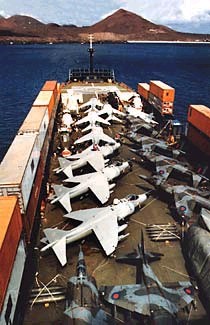
Harriers at sea on a container ship: what if they were IN the containers for camouflage (think Q-Ship), protection and later ground transport?
A gyrene, Major Andrew Shorter writes in the 2003 Naval Institute Proceedingsmagazine: "STOVL JSFs Put Teeth in Sea Basing"
www.usni.org/Proceedings/Articles03/PROshorter09-2.htm
"While a modern aircraft carrier can employ the STOVL JSF, we must examine new complementary designs that more fully would support the Sea Basing concept rather than merely providing platform space for short-term surge capability. By expanding the number of platforms available, maximum operational flexibility is attained. Because of the cost of a new ship, designing one with multiple capabilities should be a prerequisite. A suitable cost-efficient family of vessels focused on the objective capability of Sea Basing might be found with the combination of an aircraft carrier or amphibious-warfare ship and a maritime prepositioned ship. The CNO is convinced there is 'unique and powerful' potential for maritime prepositioned ships once they are unloaded.One ship design agent, Naval Sea Systems Command/Advanced Marine Enterprises, has designed several such unique ships. Cost was the principal design driver, but current and evolving technology were leveraged to develop these designs to meet the maritime prepositioned group's Sea Basing capability. One design incorporates the facilities of a maritime prepositioned ship, including cranes and a roll-on/roll-off ramp, along with the helicopter capability of an amphibious assault ship (general purpose), albeit with fewer operational spots. The aviation-capable design has a dedicated flight deck designed for helicopters and STOVL aircraft, which gives the impression of an aircraft carrier. However, most of the below-deck spaces are dedicated to roll-on/roll-off and cube cargo, along with aviation fuel and ordnance. This concept capitalizes on the AIAA finding that 'V/STOL can provide equal or better [mission] performance with many less aircraft.'
Fewer aircraft require less hangar space, fewer maintenance and support personnel, and for STOVLs, fewer ship systems to support them and a much smaller air department. STOVLs require 30% less deck space for operations, which leads to increased operating efficiencies.20 Those efficiencies allow generation of more sorties given equal mission performance. For example, STOVL aircraft can generate 30% more sorties than CTOL aircraft for targets out to 400 nautical miles, and 15% more for ranges to 700 nautical miles.21 The affordable combination of multiple missions within one hull design can become a reality based on our emerging technology.
Although Sea Basing may be seen as a transformational concept, and the notion of using cargo ships as aircraft carriers while allowing Air Force pilots to fly from them seems to support transformation, there is a historical precedent. During the 1982 Falklands campaign, Great Britain executed a version of Sea Basing to support Operation Corporate and its retaking of the islands. It did not do this in answer to any new doctrinal concept, but of necessity. Operation Corporate highlights the two topics important to the STOVL JSF's support to Sea Basing. The first is the use of non-purpose-built ships as aircraft carriers. The Atlantic Conveyor, a commercial container ship, was pressed into service as a transport for Harriers, helicopters, spare parts, fuel, ordnance, supplies, and equipment. The converted ship originally was not intended to launch operational missions, but it had two operational deck spots, one of which was manned by an armed Sea Harrier during transit from Ascension Island to the task force. Although there was no operational employment of the fighters from the Atlantic Conveyor, the V/STOL aircraft remains the only type of fighter aircraft that can, and did, self-deploy and redeploy to and from that type of vessel.
The second topic has been incorporated as part of Great Britain's strategy for projecting combat power. This concept involves using the Royal Air Force (RAF) as a member of the deployable sea-based air arm. (The concept is still in use today under the title "Joint Force Harrier.") The RAF's early adoption of V/STOL aircraft was the critical element that allowed it to espouse this idea. V/STOL aircraft negate the greatest danger of fixed-wing shipboard operations-the speed at which the aircraft approaches the ship when landing-and can use normal land-based confined-area landing techniques to safely land on any suitably sized deck at sea. The RAF pilots proved this point as many of them executed their first shipboard landings, embarking on board the two aircraft carriers of the task force en route to the South Atlantic. By supplementing its task force with container vessels and transporting V/STOL strike-fighter aircraft, operationally manned by squadrons from two different services, the United Kingdom provided an unprecedented, unforeseen, highly flexible power projection and sustainment capability."
What's interesting is that TODAY with the F-35 Joint Strike Fighter (JSF) which can land and take-off from a hover using life-fans and a vectored rear exhaust nozzle could do fleet air defense just like the Hurricat did from any ship with a landing pad and not have to be discarded in the water.
Experience with vectored thrust fighter-bombers like Harriers has been disappointing in that a hovering take-off with a useful load is not possible in most situations--maybe a light load of just air-to-air missiles-- and maybe not. Certainly not a heavy bomb load. The Hurricat WW2 example again reminds us that we could attach a rocket motor to the F-35 JSF and get a ZEro Length Launch (ZEL) as we pointed out a few months ago in AVJ which was highly successful in USAF tests. The USAF ZEL technique in the `60s had the same problem as Hurricats had in the `40s: the conventional runway airplane you mated the rocket to still needs a place to land after the mission. Mating ZEL to the F-35 which can certainly hover land when near empty of payload (STOVL) would enable the USAF operate completely away from long runways and the Navy to not need large aircraft carriers AT ALL. Maybe this is why the Navy and USAF are lukewarm about the JSF as its a threat to their pampered air bases and aircraft carrier existences?
Naval Air Strikes/MIG CAP from small combat or non-combat vessels: seaplane F-35 JSFs
Its true that heavy bombers are more efficient than small fighter-bombers and the jet seaplane patrol bomber should replace the converted civilian airliners the Navy now use for patrol missions to gain inland bombardment and JCSAR/SOF insertion/extraction capabilities via water-landing and take-off capabilities.
Details: www.combatreform.org/p6mseamaster.htm
However, heavy bombers will need combat air patrol (CAP) coverage against possible enemy nation-state fighters. Must we get these CAP fighters just from land or large, vulnerable, expensive aircraft carriers? The answer is obviously no with the advent of the F-35 STOVL which can operate from small ships using its hovering capability and ZEL rockets. And the truth is we could have and should have been operating seaplane fighters from our battleships, cruisers and destroyers all along. Before considering the litany of can't-do reasons from those who cling to the large aircraft carrier, consider what $5 BILLION can buy us if we opt to not spend it on another aircraft carrier. The first thing, is we can easily develop and perfect a ZEL rocket bottle system for the F-35 JSF. Next, we could develop some long skis that would retract out from the left/right of the JSF so if for WHATEVER THE REASON IS it cannot land on the ship it can glide to a water landing. If for whatever the reason is, the JSF can't use its hovering capability, if its still flyable through forward motion the skis would enable us to save its pilot(s) and the $40 million plane. The O-1 Bird Dog with snow skis and the Pantobase skis could enable even a non-floatation hull to stay above water as long as the plane kept moving in the water. When the plane slows, inflatable pontoons would pop-out from the skis to float the plane until it can be craned back aboard the ship. At the very least, floatation materials should be in the plane so it can be recovered and repaired. This is not some small issue.
Look Ma! My plane floats! You don't have to pay for its replacement in your taxes!
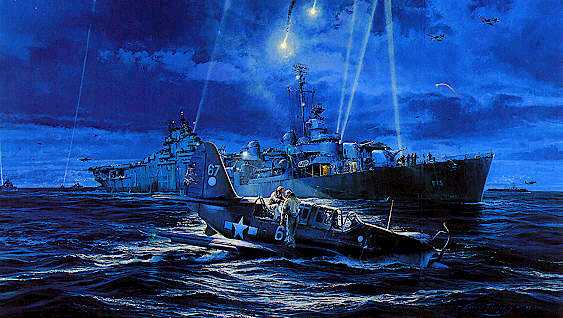
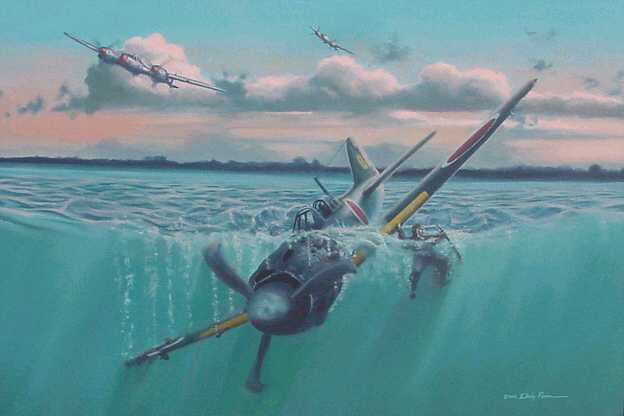
The Navy has always had a very hard time keeping its steam catapult and arrestor wire for tailhook large aircraft carriers fully stocked with land wheel equipped airplanes hardened for these high-g type landings. When an airplane misses a wire and loses power its going into the drink as a total loss. The British, Canadian and Australian navies simply went broke and ran out of A-4 SkyHawks and F-4 Phantoms to keep their large carriers functional with airplanes. When you consider a F/A-18F costs $65 million and we lose a dozen each year in accidents, its not surprising that the Navy is so desperate to rationalize it aircraft purchases so its going to soon be flying just F/A-18s as we say adieu! to the F-14 Tomcat, the S-3 Viking, and next the EA-6B Prowler. The A-3 SkyWarrior, which was the most capable tanker is looong gone and is perhaps now being crashed into buildings to look like terrorist airliner hijacks. Our carriers will (until the JSF arrives) have just overweight and jack-of-all-trades, masters-at-none F/A-18s for everything except AEW and COD which are done by E/C-2 Hawkeye/Greyhound turboprops. With even the USAF's F-15Cs which are far more maneuverable and fast than Hornets losing to the lowly Indian Air Force in recent air-to-air combat maneuvers, its not hard to imagine the USN not having either the qualitative and quantitative edge against say the Red Chinese over the straits of Taiwan.
If on the other hand, the Navy were to be wise and buy the "B" STOVL version of the F-35 JSF, it could have the skis described above fitted so if the aircraft cannot come aboard the carrier due to battle damage to itself or the carrier---face it---this has happened in the past and will happen again in the future---the aircraft can be recovered and reused from small ships or the water. The monies saved from not throwing away aircraft each year into the ocean would enable us to build up more aircraft numbers so we are ready if we have to face an inland nation-state air force with hundreds of less expensive land based fighters-remember they have "home field advantage". However former Secretary of the Navy, Gordon England now elevated to Assistant Secretary ofd Defense is pushing for the USAF to buy the heavier landing gear/air frame CTOL F-35C to boost numbers since aircraft carriers eat airplanes for breakfast, lunch and dinner and cut costs. The USAF could theoretically cross-train to land on Navy carriers like the RAF does with STOVL Harriers. However, the USAF doesn't want to either give up its comfy land air base M.O. with STOVL F-35Bs or get sea sick helping their rival Navy air arm stay in existence with carrier landings, they'd just opt to drop out of the F-35 program entirely and go with their ego mount F-22s. Both the Navy and USAF should go to the F-35B STOVL to gain new capabilities they do not have; aircraft recovery in the event of aircraft carrier losses, ability to operate from small ships and mobile forward operating bases.
Iowa class Aircraft Battleships and Thru-Deck DD(X) Assault Carrier and the F-35 JSF STOVL
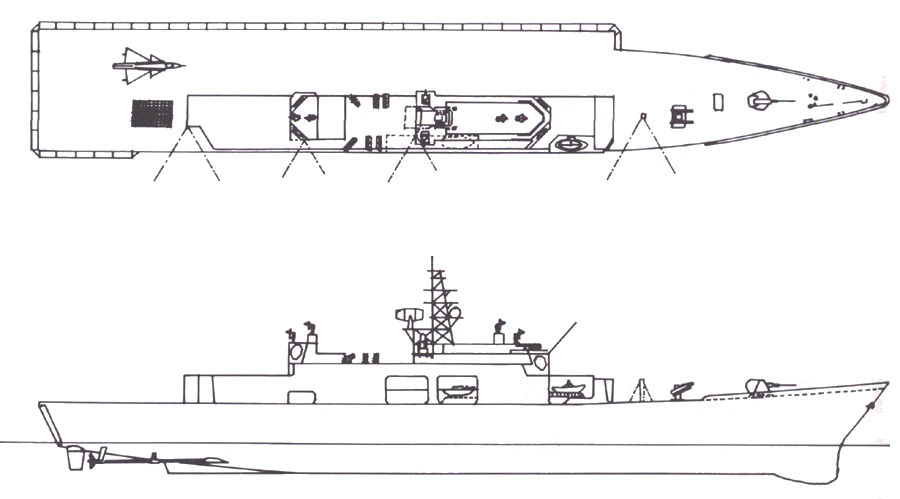
Now back to the $5 BILLION we saved and only spent a few million developing skis/pop-out pontoons for the F-35 JSF. Critics of the decentralized onto small ships approach will cite the huge amounts of fuel, ammo, ordnance required to keep these fighter-bombers in action to reverse-engineer you to re-accept their large nuclear-powered aircraft formula. For $5 BILLION we could instead buy 5 x DD(X) ships with a ski jump front flight deck and link it to the rear helipad through the entire length of the ship by making the superstructure open in its middle so planes as they land can be towed inside and refueled/rearmed. Then as the are towed forward, they are placed on the front ski jump section, blast deflectors raised and launched by their own power and/or ZEL rockets with the ship facing into the wind.
Even better than soft-armored DD(X) would be making our hard-armored Iowa class battleships and making them into Aircraft Battleships to employ F-35 JSFs. Details:
BBG-21s: what we need for the 21st Century
Legendary DoD reformer and weapons designer Chuck Myers writes:
"Not sure where this conversation began but you may be interested to know that when 'making the case' for reactivation of the four Iowas in 1978-79, I designed and we had built what we called the 'Interdiction Assault Ship' which was an Iowa with the rear turret removed. We covered the hole with six inch steel and installed a vertical launch missile farm that projected up into a split skijump deck for STOVL operations, helos (today V-22s). All five inch guns were replaced with 155mm turrets. CONOPS was for the ship to act as a hot deck for various air ops. It had a rear deck elevator and coud house about eight Harrier sized aircraft below in the now hangar bay. It attracted a lot of attention and caused a Navy internal study of Battleship Battlegroups to compliment CV Battlegroups. It helped bring about the acceptance of reactivation but was later discarded (excuse was money). Guess how many CM were in the farm: 320!!!!! Plus six 16" guns and lots of 155s. On a platform which could withstand any ordnance existing in the world. A WAR machine which also served as the command/control ship for the force. The hangar bay could also serve as the temporary home for hundreds of marines or SOF forces.. Had a six foot long model constructed which sat in the Pentagon for about ten years where it was viewed by folks who took the 'tour'.
Still a good idea."
Chuck
This idea that we need a huge, top-heavy angled-deck aircraft carrier comes from the fact that we have airplanes rolling in at hundreds of miles an hour and slamming on top to land and if they don't catch a wire need to keep on going and come back around for another try. We don't need such a large, vulnerable and costly ship to operate F-35 STOVL JSFs. 5 x DD(X) Assault Carriers with 24 x JSFs = 120 JSFs which is far more combat power than the 85 fighter-bombers the large aircraft carrier carries and then proceeds to lose through normal operational attrition. Now the Navy's F/A-18s and E/C-2s will still need large aircraft carriers to operate from, so aircraft carrier lovers need not worry-yet.
If you don't want small aircraft carriers fine, use the $5 BILLION to buy 100 x A-40 Russian jet seaplane patrol bombers for the Patrol Navy to get some of the funding for a change.
F-35 JSF STOVL for Special Operations
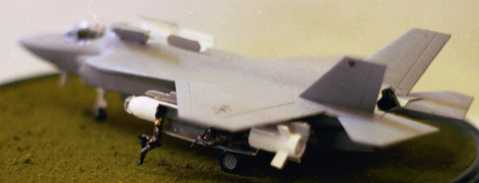
 www.youtube.com/watch?v=kanGcGiEKyY
www.youtube.com/watch?v=kanGcGiEKyY
 www.youtube.com/watch?v=w_Iw3Z6Dh8g
www.youtube.com/watch?v=w_Iw3Z6Dh8g
Another interesting tidbit from the Japanese secret airplanes documentary is that the Japanese Army-that's right-the Army---had aircraft carriers in WW2! The Army took a cargo ship and put a flight deck on it, calling it the Akitsu Mara. This exactly what we propose we do to a Roll-On/Roll-Off sealift ship to enable our primarily Army Special Forces to have a sea-based means in our Non-Linear Maneuver Brigade (NLMB) proposal:
What's even more fascinating is the Japanese Army put V/STOL aircraft on the Akitsu Maru!, their up-engined Kellett autogyros, the KA-1s for artillery spotting but in this case for anti-submarine warfare. Their KA-1s had a 85 kg depth charge in place of a co-pilot and this resulted in the Japanese Army in WWII as the first to successfully use helicopters in combat when they sank a U.S. Navy submarine-not the U.S. marines who try to boast their lift of troops in Korea was the first combat helicopter use. The Germans had troop-carrying helicopters in WWII and are reported to have done the first troop air assaults. The U.S. Army in Burma did the first helicopter combat rescue in 1945. The Russians also used autogyros in WWII in combat.
TO BE HIGH SPEED OR NOT TO BE HIGH SPEED?
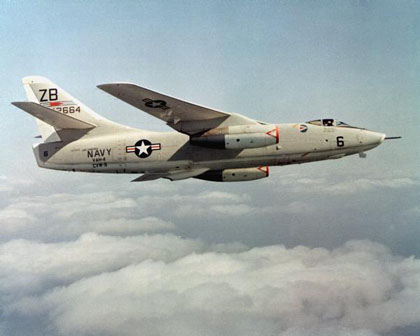
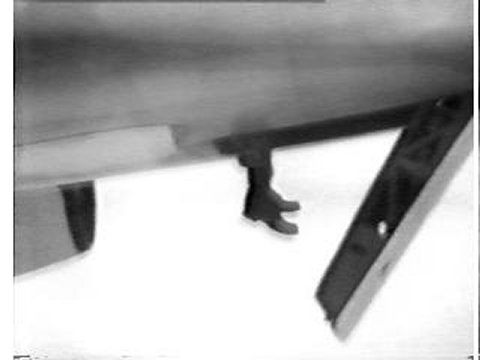
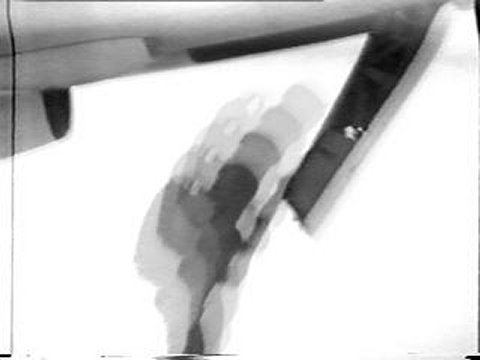
"Get set, Go!!"
Marv Cohen, 2nd Force Recon marine is making a planned jump from a TA-3B in 1962. This action was captured from a video TV series made by CBS called "The Twentieth Century" narrated by Walter Cronkite. It chronicles the story, among other things, of a marine recon unit leaving an aircraft carrier via an A-3, dropping to an assigned sector, completing their recon mission and being picked up and returned to the carrier via a twin, piston-engined C-1 COD plane. Pics submitted by 'Rock' Guthrie, USMC (Ret)
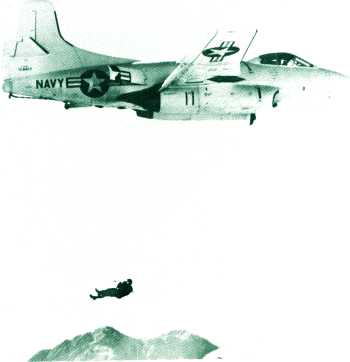
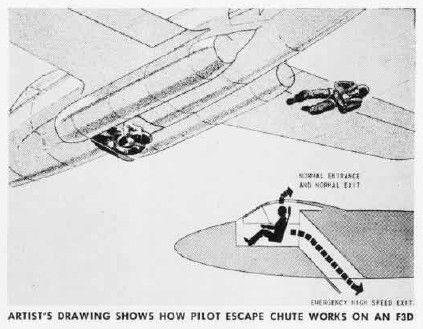
We don't have a pic of an operational paratrooper exiting an A-3D but this picture of U.S. Army Captain Jacques Istel testing a parachute after sliding down the very similar Douglas F-3D SkyKnight's escape tunnel shows how a jumper would appear from an A-3. Both the SkyKnight and SkyWarrior were designed by legendary Douglas engineer, Ed Heinnemann.
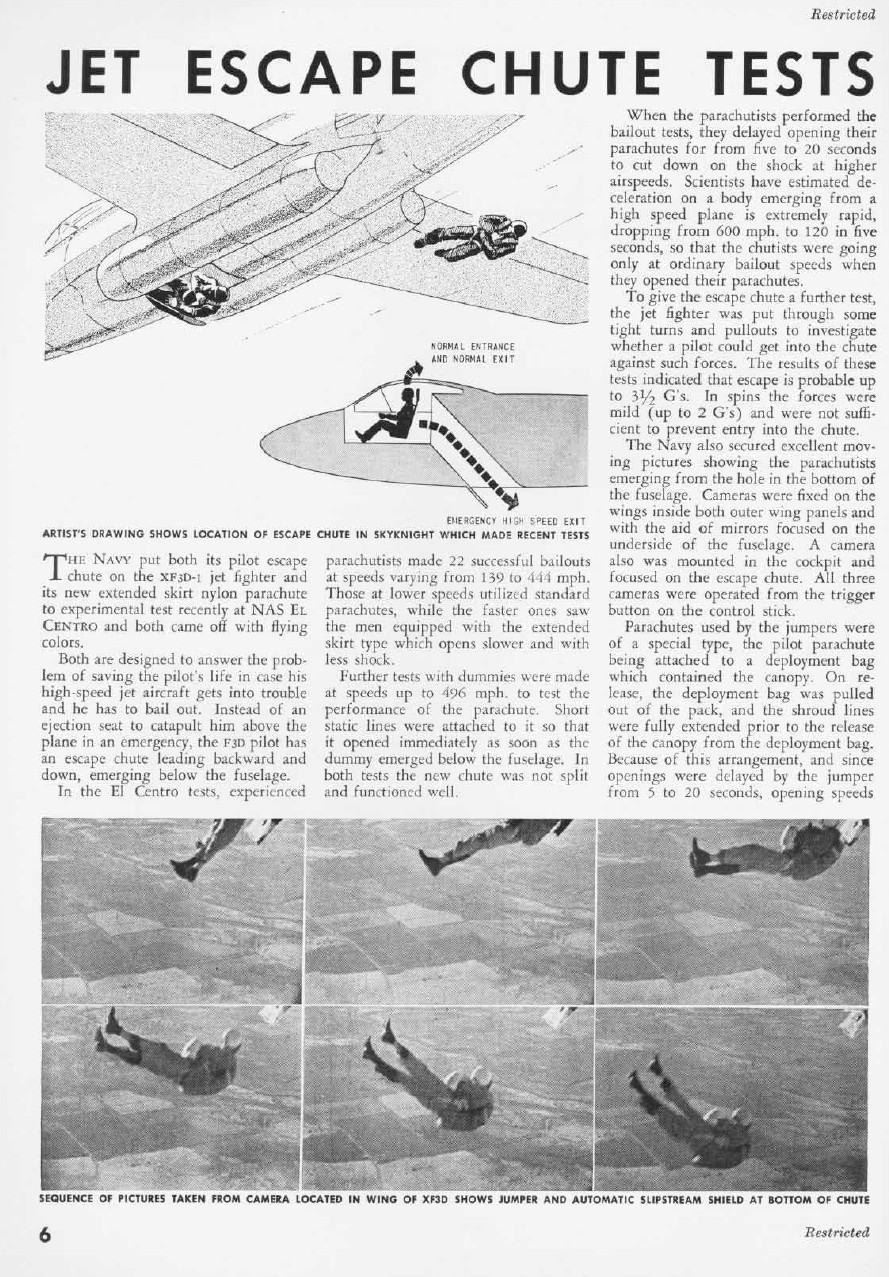
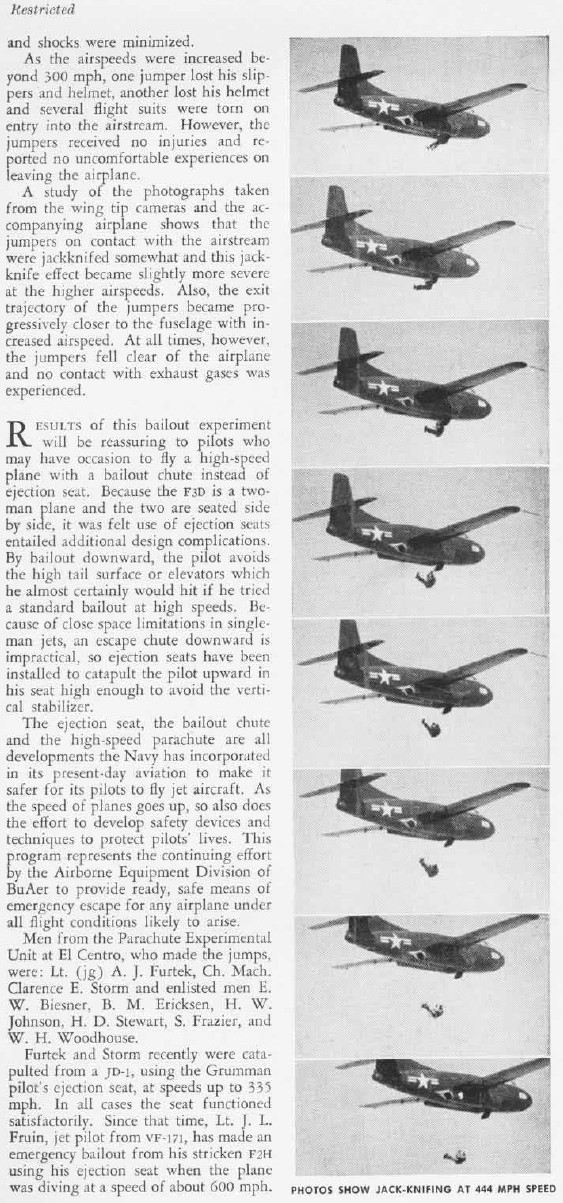
We used to actually be "high speed" when we were more physical and less mental. An USMC Force Recon team could take-off from a Navy aircraft carrier in a 500+ mph A-3D SkyWarrior JET bomber and then parachute insert using the escape chute to do ground reconnaissance missions. The enemy would think a bombing mission had taken place from visual and radar observation. With today's military freefall (MFF) ram-air parachutes a 23 mile stand-off using their 3-to-2 glide ratio and oxygen bottles could add to insertion range.
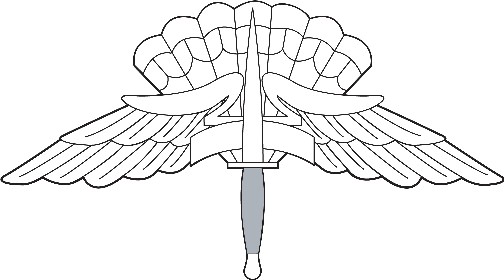
The sad news is the navy retired its carrier-capable jet transports and now only has the slow-speed and obvious C-2 Greyhound COD prop plane to insert SEALs and force Recon, fooling no one alert. The fighter-bomber jocks running the USAF and USMC have long retired the OV-10 Bronco twin-turboprop observation/attack plane that could insert small numbers of recon personnel.
Its high time to be "HIGH SPEED" again!
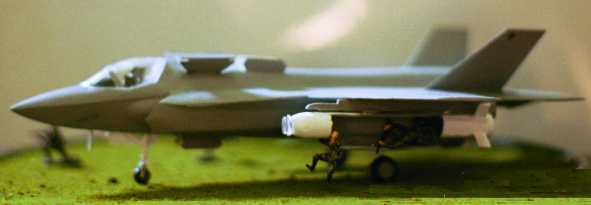
For the NLMB RO/RO Commando Carrier, we propose a mix of Little Bird helicopters, STOL U-27s and C-27J aircraft that can as needed be bolstered by F-35 STOVL fighter-bombers. Consider it one of the $1 BILLION expenditures from the 4 other DDX(X) Assault Carriers. What's intriguing about the F-35 is that it's a supersonic somewhat radar stealthy fighter-bomber that can fight its way through enemy defenses and then land nearly anywhere using its hovering capabilities. To insert a special operations team, under its wings special 1 or 2-man JPODS could carry 2-4 men in or out after flying an attack mission profile. The enemy would not see a slow lumbering V-22 with forward- facing windmills obviously inserting/extracting troops at 300 mph, but only a high subsonic fighter-bomber with their eyes and not much on their radar screens after dipping to a few feet above the terrain contour. Why penetrate enemy air defense at a mere 300 mph and defenseless when you could be going 600 mph+ and armed-to-the-teeth? The JPODS costs would be small peanuts from the $5 BILLION pot we have to work with.
Web page on the history of "People Pods":
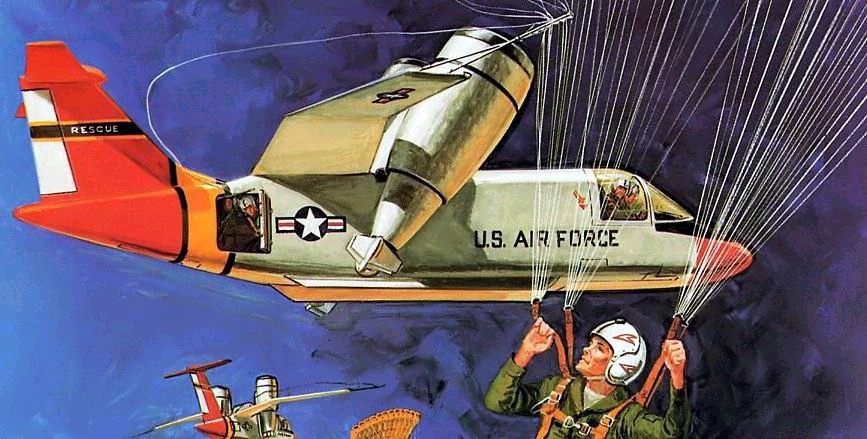 www.combatreform.org/escape.htm
www.combatreform.org/escape.htm
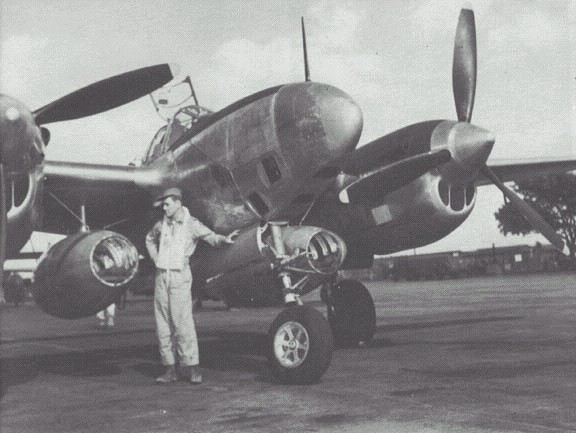
P-38 Lightning I with People Pods in WW2
A Mid-Air-Recovery System (MARS) might be able to "snatch" pilots who have ejected under canopy and fly them to safety without reaching the ground to be captured or used as "bait" to cream the rescue force.
The two-seat version of the JSF should have the rear crewman facing AFT to be a better look-out for enemy fighters and assess strike damage, JU-87 Stuka, IL-2 Sturmovik and SDB Dauntless dive bomber-style. One AIM-9Z Sidewinder missile should always be facing rear-ward with a special tail cone for the rear crewman to fire it if they are "jumped" by an enemy fighter. The Russians have already done tests and made the rearward fired missile a reality. Both crewmen should have helmet-slewed and aimed missile firing capability like the latest Red Chinese fighters have.
So for $5 BILLION not spent on yet another expensive aircraft-eating carrier we cannot afford, we could have:
· F-35 JSF skis and pop-out floats as standard equipment to reduce aircraft ditching losses/improve safety
· ZEL rocket systems for small ship and no runway operations capabilities
· 1-4 DD(X) Assault Aircraft Carriers carrying 120 x F-35 JSFs
or 100 x A-40 MMA jet seaplane patrol bombers
· or 1 RO-RO Commando Carrier for a USSOCOM NLMB
· 1-2 man JPODS to insert/extract SOF and do JCSAR
· 2-seat version of JSF with second crewman facing aft to act
as look-out/rear gunner
· Rearward firing self-defense air-to-air missiles
Twin F-35: "MV-70" Supersonic Joint Assault-Strike Fighter vs. mechanically unreliable and slow V-22: a modern "Twin Mustang"
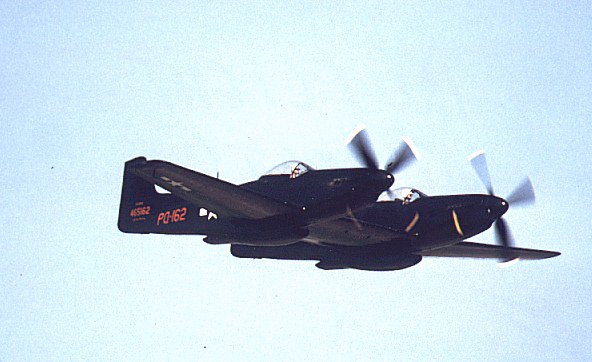
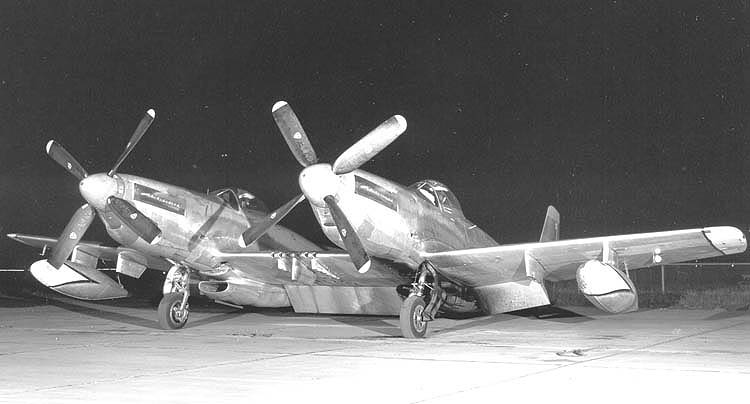
The sad truth is that the $80 million each V-22 is a costly and unsafe mechanical deathtrap. For all this cost it cannot deliver more than 24 men and cannot carry a light tracked armored fighting vehicle (AFV). Any units the V-22 delivers ashore will be foot-mobile and fighting the enemy "even" hand weapons versus their hand weapons or worse outnumbered and outmatched if the enemy has AFVs. There is no guarantee that the 300 mph and extremely-obvious-on-radar V-22 tilt-rotor will even survive through enemy air defenses as RAND likes to point out. After 15 years, over 30 deaths and $15+ BILLION its simply time to cut our losses before we start killing 24+ men and $80 million of aircraft on a daily basis until we say "Uncle!" like we had to do with the B-58 Hustler supersonic bomber.
A far better global reach than V-22s would be to develop a nose- loading, 4-engine version of the Russian A-40 jet seaplane that the Navy should first buy in twin-engined form for its MMA replacement of its worn-out P-3 Orion civilian airliners. A pair of waterjet equipped M113 Amphigavins could splash out of the "A-80" jet seaplane with two marine rifle squads inside to eliminate the entire thousands of marines packed in vulnerable amphibious ships like sardines, disaster waiting to happen. Its as if the navy/marines do not even read Naval history and remember the fate of the HMS Repulse and Prince of Wales in WWII which were sunk by Japanese planes in WWII because they didn't have any air cover and were thought to be able to defend themselves with just anti-aircraft guns. Must we lose thousands of men packed in a ship before we learn to not do this?
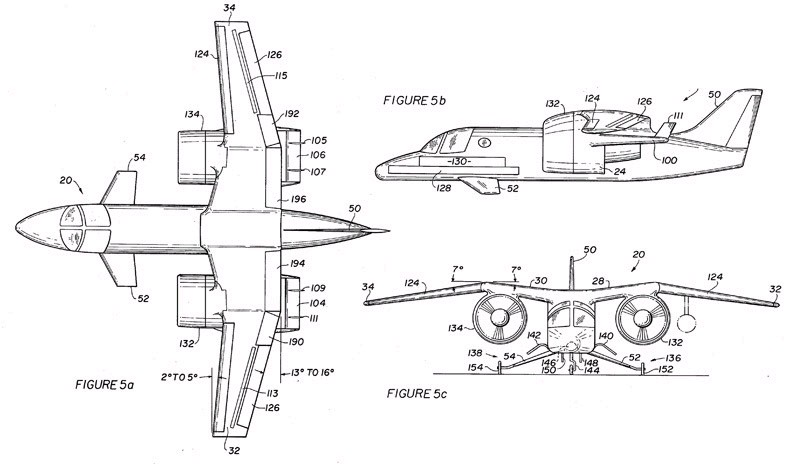
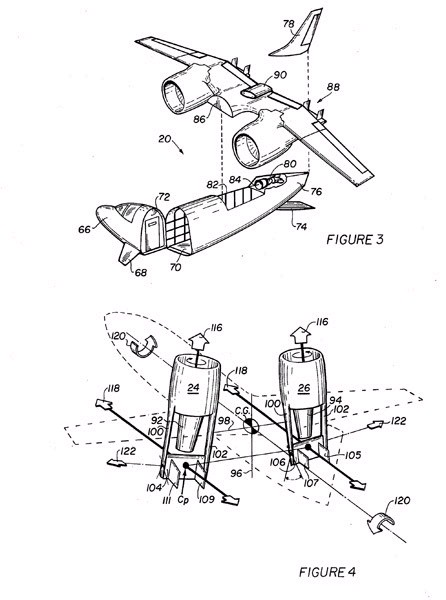
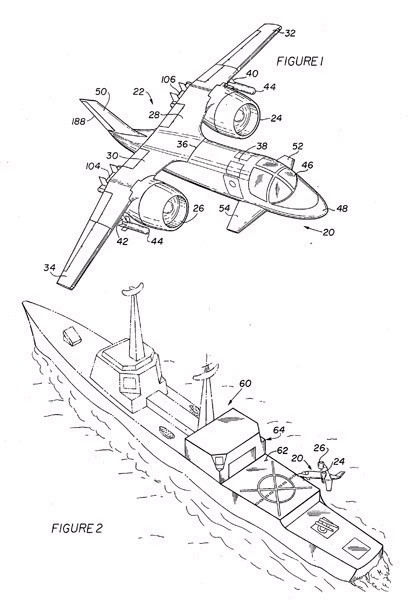
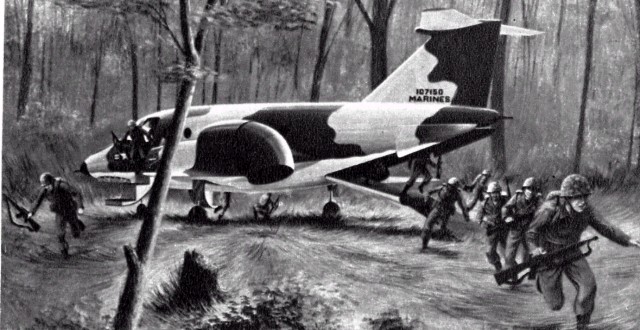
However, for deeper inland insertions/extractions of SOF personnel, USSOCOM needs a plane that can land within extremely short distances (ESTOL) or from a hover (vertically) and not be a mechanical deathtrap like the V-22 is. The program to replace the current STOL MC-130 Combat Talons 4-engined turboprop planes is called MC(X). Stealth is a desirable feature of MC(X).
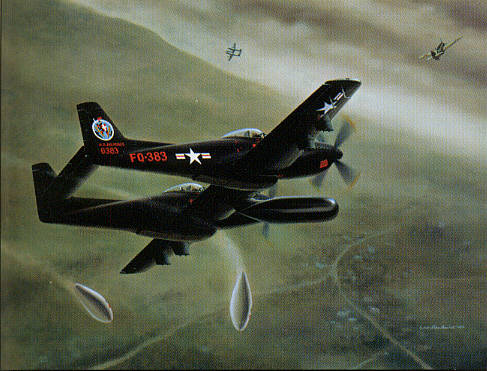
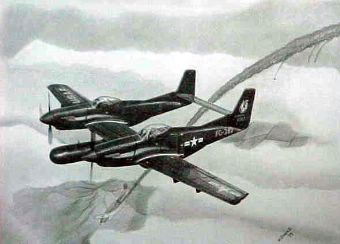
The question is, why not connect two F-35 JSF STOVLs TOGETHER like the highly F-82 Twin Mustang was in Korea with an integral or detachable pod in the center (OV-10 Bronco style) to insert/extract up to 30 SOF operators? The F-35 STOVL life-fans are already able to take-off and land with far greater positive lift safety than the notoriously dangerous hang on a column of hot air Harrier vectored thrust jump jets. It should not take a multi-billion dollar R&D program to make a Twin Joint Strike-Assault Fighter "MV-70" but we should re-allocate $1 BILLION from canceling the V-22 to get a supersonic Airborne/Special Operations insertion/extraction capability. We talk endlessly about jet thrust V/TOL troop assault transports visualized on TV with shows like the Thunderbirds, and movies like Aliens 2 and Starship Troopers. Why just talk about it? Combine two F-35 JSFs and THIS WILL BE REALITY NOT SCIENCE FICTION.
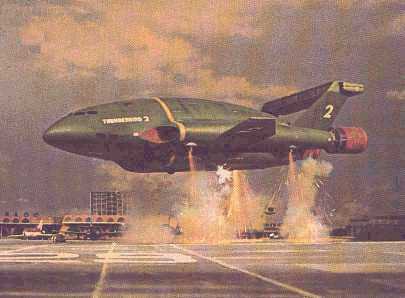
The MV-70 would have all of the high-speed and stealth features described before that make it far more survivable and powerful than the pitiful V-22. However, by having a large cargo area in the center, Airborne/Special Operations troops would be able to jump from the rear ramp for military freefall (MFF) HAHO or HALO, or static-line parachute insertions. The MV-70 could even hover 5-10 feet over the water and troopers could "helocast" (not a helo but go with it) with swim fins and or a Zodiac boat with outboard motor to insert by water. The MV-70 might be able to hover over a dry insertion point and have them slide down fat "fast ropes" like firemen going down poles. Another option is the center section of the MV-70 could be modularized so detachable multi-mission pods could be attached; a pure cargo pod could do the COD mission of the C-2 Greyhound, an AEW pod could replace the E-2C Hawkeye, and with it the last remaining reason why we absolutely MUST HAVE large aircraft carriers. The center troop pod could be a X-38 lifting body shape that could detach miles away from the insertion point and then deploy a large ram-air parachute to effect stand-off, stealthy airborne glider assaults which were extremely effective at gaining coup de main surprise in WWII at Eban Emael, the Gran Sasso rescue of dictator Mussolini and at Pegasus Bridge on D-Day.
And last but no means least, the MV-70 could land by lift-fans and vectored thrust nozzles to insert and later extract the Airborne or Special Operations troops---a totally new capability for long-range missions. For the second attempt to rescue the Iranian hostages, we had fitted enough JATO rockets to a C-130 "Credible Sport" to land and then take-off from a soccer stadium; with MV-70 this would be a reliable and safe reality.
For $1 BILLION we should be able to get two squadrons of MV-70 supersonic stealth transports in addition to the amazing capabilities gained by not wasting $5 BILLION on yet another large aircraft carrier.
But F-35 STOVLs for Close Air Support? NOT
Legendary combat airwar tactician Chuck Myers reminds us:
"I suggest we rethink your view of the value (?) of the Harrier, especially for MAS or CAS of ground forces.
I will agree, however, that it is FUN to fly and is superb for airshows.
However, our (OSD/Joint) formal two year intensive aircraft vulnerability study (circa 1985-87) of all tactical aircraft awarded the AV-8B the prize as being THE most vulnerable aircraft to small arms fire. As you would expect, the A-10 was the least vulnerable and by a factor of ten.
In keeping with the original purpose of Harrier (low altitude nuke strike from a hidden location/NATO Strike Fighter competition), there was no armor, no foam in the fuel tanks to inhibit explosion, fuel encased inside the walls of the INLET DUCT (unbelievable), and main fuel stashed directly above the engine with NO FUEL TANK SELF SEALING!!! I don't recall having flown a Navy fighter/attack airplane which lacked self-sealing tanks.
The Harrier is so short on fuel that they cannot tolerate the volume/weight toll that selfsealing and foam in tanks would take on range/loiter.
On top of all this, the location of the IR target hot exhaust was up under the wing root near the fuel ---- great. Naturally, all this evolved tactics which prohibit attacks from below 10-12000 feet. Such characteristics induced a pilot demand for 'STAND-OFF' (all the way back to the O'Club might be sufficient).
Re: UK employment in Falklands which many sight as a demonstration of its utility: the AV-8 was their ONLY seabased interceptor and in this role it contributed to warding off the A-4 and Mirage sea skimming attackers, but not so well. If every bomb or missile that hit, penetrated, passed thru or lodged inside a British ship had detonated, the UK would have clearly lost the war (Arge armorers were just learning the trade of fusing for low altitude attack).
When the Harriers went to the beach on interdiction missions, they had a very bad experience simply because they cannot tolerate being hit. Their attrition in there was double our average attrition in Vietnam. On top of all this (based on my personal evaluation flights), Harrier has very poor cockpit visibility for the CAS mission.
Re the USMC pilot attrition (killed): it destroyed their very best (hand picked guys).
Other: we bought some AV-8A as an experiment. That should have been the end of it but in Washington, 'getting the Camel's nose under the tent' is still an effective tactic. We paid for the "A's" twice (rehab program); the second time at a cost over twice the initial procurement (in same year dollars). A GREAT program for the industrial-political coalition.
Overall the Harrier program stands as one of our worst examples of U.S. Defense Acquisition. The USMC traded them for A-4's, the most survivable jet airplane during Vietnam. And, the A-4 demonstrated the same toughness in the Falklands fracas.
I personally tried to stop the AV-8B procurement and nearly succeeded. I was defeated by the unexpected political move of UK MoD and MacDoug(US producer): the UK MoD proposed that if the US bought the Harrier they would buy the AWACS. I departed the DoD. The U.S. bought the Harrier (AV-8B) ---- the UK then backed out of the AWACS [uses Nimrod for AWACS].
I expect little real value (re: MAS/CAS) from the JSF series and suggest to you that the cost will eventually reduce or terminate the program (of course, after we have sunk a few billion). Future "grunts" should not count on it for effective/timely air support.
Just to remind: in the funded study for OSD (1998-2000), most of which is captured in our web site on Maneuver Air Support, the ideal airplane evolved. It was capable of operating from a carrier without catapult or arresting or from a dirt strip. It was powered by the GE Unducted Fan in a pusher configuration. Provides near instant take-off, very long loiter and for recovery you merely go to reverse pitch an instant before touch-down. Picture is presented in the presentation. A LOT of engineering went into that design (by guys who had worked the mission problem for three years). Also had lots of armor, reduntant control artieries, CM, great cockpit visb, good low speed qualities for working under weather in rough terrain and a Vmax of 450kts for getting TO the fight, etc. Probably a $10M per copy airplane.
Engineering is NOT our problem. The obstacles are ignorance and cultural and dedication to maintaining communities and stovepipes. AND an absence of senior Army Infantry Officers with BALLS enough to reverse the Crap that happened in 1947."

Converting Supply Ships to Aircraft Carriers and Amphibious Assault Ships: do-able
Contrary to popular misinformation from the USMC ego PR machine, the first amphibious assault aircraft carriers were Japanese not American. The U.S. amphibious ships in use today are also the fruits of the U.S. Navy, not the marines. The concept of converting a RO-RO Ship to a Commando Aircraft Carrier is sound and proven. Even having it operated by someone other than the Navy is also sound. The Japanese ARMY, that's right--the ARMY operated combination aircraft carriers and amphibious assault ships converted from merchant ships in WWII. This idea that we can only have an aircraft carrier if its a huge multi-billion-dollar Nimitz class with 6,000 men is another lie foisted upon us by the current U.S. Navy brass.
Escort Aircraft Carriers
Units of the Class Characteristic
History
(a) Akitsu Maru
(b) Nigitsu Maru
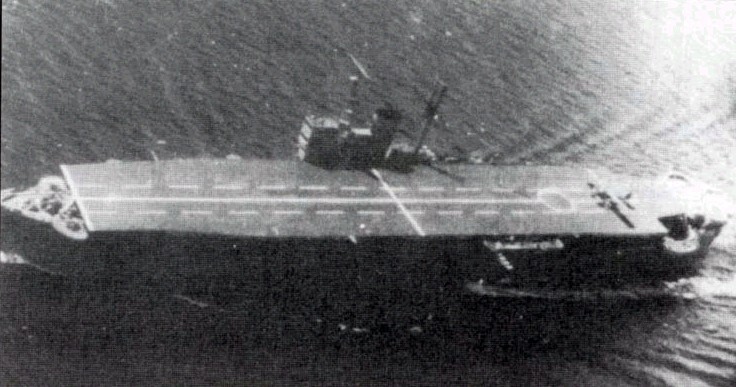
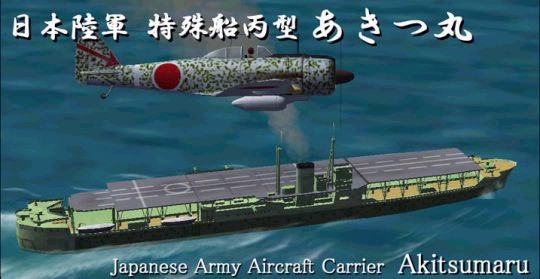
Displacement: 11,800 tons
(a) Length 480 feet
(b) Length 498 ft 8 in
Beam 64 ft
Draught 25 ft 9 in
Machinery Turbines: 4 Boilers and 1 shaft
Performance: 8,600 SHP; 20 knots
Flight Deck: 404 feet x 74 feet, 1 Lift
Aircraft: 20
Guns 10 x 75mm; 2 x 77mm primarily for Anti-Aircraft
Imperial Japanese Navy was not the only service to operate with carriers. In early 1941, the Imperial Army projected to convert some merchant ships into assault ships under their command. These vessels could be used both as troop transports and aircraft's transports
Reconstruction was limited to redirecting boiler uptakes to the starboard side to emerge in a single funnel. A small flight deck was fitted over the superstructure. JAAF aircrafts could not only be transported, but also flown off to assist landing forces in the rapid establishment of a land-based air defense unit. Twenty standard landing crafts could be carried.
Details of wartime operations not known. Both ships, Akitsu Maru and Nigitsu Maru, were sunk by submarines during 1944.
Chigusa Maru
Yamashiro Maru
Displacement: 11,800 tons
Length: 151 meters
Length 157 meters
Beam 20 meters
Draught 9 meters
Machinery Turbines: 2 boilers and 1 shaft
Performance: 4,500 SHP; 15 knots
Range: 9,000 NM; 13 knots
Flight Deck: 152m x 23m; no lift
Aircraft: 8
Artillery 16 x 25mm Anti-Aircraft guns
Yamashiro Maru commissioned: 27 January 1945
Imperial Japanese Army acquired two tankers in 1944 to convert into escort carriers for army convoys. These carriers operated with Japanese Army's fighters Ki-44 in a limited air and ASW defense role over troop convoys. Only Yamashiro Maru was commissioned.
Yamashiro Maru was the only ship of this class which was commissioned. She was sunk by U.S. aircraft in February 1945.
Kumano Maru Displacement: 8,000 tons
Length 480 ft or 501 ft
Beam 64 ft 3 in
Draught 23 feet
Flight Deck: 361 ft x 60 ft 6 in; no lifts
Machinery Turbines: 4 boilers and 2 shaft
Performance: 10,000 SHP; 15 kts
Range: 6,000 NM a 17 knots
Aircraft: 37
Artillery: 8 x 75mm, 6 x 25mm
Commissioned: 30 March 1945
According to concept of amphibious assault ship, Imperial Japanese Army acquired a small transport ship for conversion with a similar scheme to Akitsu Maru class.
The army aircrafts could be deployed to assist landing forces in the rapid establishment of a land-based air defense unit but not could be recovered. 13 standard or 40 smaller landing crafts could be carried.
Kumanu Maru was not employed in operational services. After the war, she was used as transport.
Not only did the Japanese do what we are proposing to do for the NLMB, they employed the world's first helicopters in combat (again, NOT THE USMC). They employed KA-1 autogyros that succeeded in sinking a U.S. submarine with depth charges.
http://pub131.ezboard.com/fjpspanzersfrm39.showMessage?topicID=124.topic
Sky-Writer
by Jeff "JDG" Goldstein
Kayaba Ka-1 helicopter
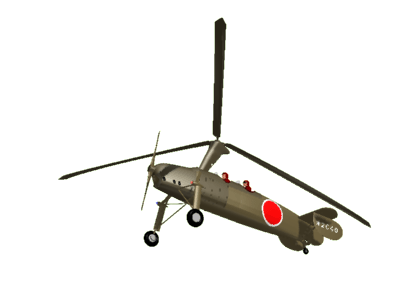
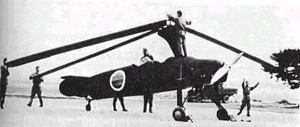
Although relatively unknown the Kayaba Ka-1 autogyro deserves a special place in aviation history since it was the first armed autogyro/helicopter to have been used operationally.
In the late 1930s the Imperial Japanese Army began to show considerable interest in the use of the autogyro as an artillery spotter and in 1939 a Kellet KD-1A single engined two seat autogyro was imported from the United States. Powered by a 225hp Jacobs L-4M4 seven-cylinder air cooled radial engine, the KD-1A featured an advanced version of the Kellet direct control rotor system. Unfortunately, shortly after its arrival in Japan, the aircraft was seriously damaged during the flight trials at low speeds. The Kellet KD-1A had been damaged beyond repair, but the Japanese Army delivered the wreck to K.K. Kayaba Seisakusho, a small company doing autogyro research, with instructions to develop a similar machine.
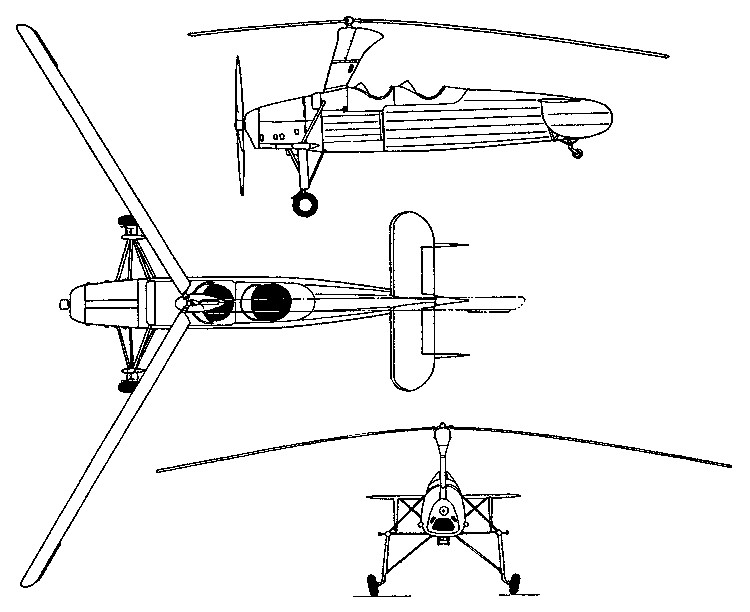
The Kayaba engineering team developed a two seat observation autogyro based on the KD-1A modified to Japanese production standards. Designated Ka-1, it was powered by a Kobe built Argus 240hp As 10c eight cylinder inverted vee air cooled engine driving a two blade propeller and a three bladed rotor. Completed in May 1941 the maiden flight took place on May 26, 1941. During its flight test program, the Ka-1 performed remarkably well demonstrating its ability to take off after running on 98 ft (30m) in still air. By running the engine at full power and holding the nose 15 degrees up, the Ka-1 could hover and could also execute a full 360 degree turn while hovering. As maintenance in the field appeared to present less difficulty than anticipated, the Ka-1 was placed in production for service with artillery units.
When shipping losses began to mount alarmingly, the Japanese Army commissioned the Akitsu Maru, a converted merchant ship, as a light escort carrier. As the short take off characteristics of the Ka-1 rendered it suitable for operation from this small vessel, a small number of Ka-1s were converted to act as anti-submarine patrol aircraft. As the load carrying capability of the two-seat Ka-1 was too limited, the carrier borne conversions were operated as single seat machines carrying two 132lb (60kg) depth charges. In this role the Ka-1s operated over Japanese coastal waters, particularly over the Tsugara and Korean channels. One Ka-1 was tested as the Ka-1 KAI with powder rockets on the rotor tips to try and improve the load carrying capability while another aircraft was converted to the Ka-2 using a 240hp Jacobs L-2MA-7 seven cylinder air cooled radial engine.
Specifications:
Powerplant: One 240hp Argus As 10c eight cylinder inverted vee engine driving a two bladed propeller and a three bladed rotor
Length: 30ft 2 7/32 inches (9.2m)
Rotor diameter: 40ft 5/16in (12.2m)
Weight - empty: 1,709 lbs (775 kg)
Weight - loaded: 2,579 lbs (1,170 kg)
Maximum speed: 102.5mph (165 kmh)
Cruising speed: 71.5mph (115 kmh)
Climb to 3,280ft (1000m): 3 minutes 20 seconds
Climb to 6,560ft (2000m): 7 minutes 30 seconds
Service ceiling: 11,485 feet (3,500m)
Range: 174 miles (280 km)
Crew: 2 (pilot and observer in tandem open cockpits)
Armament: 2 x 132lb (60kg) depth charges
Production: Approximately 240 x Ka-1s including 1 Ka-1KAI and 1 Ka-2 conversion
JDG
Sources:
Rene Francillion, Japanese Aircraft of the Pacific War, Naval Institute Press, 2000.
Elke Weale, Combat Aircraft of World War Two, Bracken Books, 1985.
American Army Aircraft Carriers in WWII
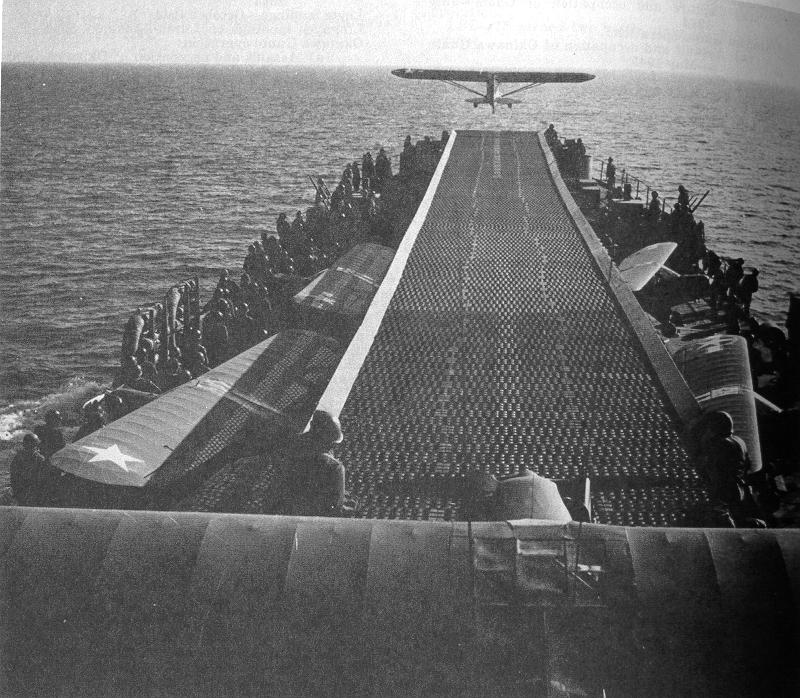
Another little-known secret is the U.S. Army fledgling Aviation branch shot little Grasshopper fixed-wing artillery observation planes off expedient decks on LST ships. They even had a "fly catcher" aerial recovery system.
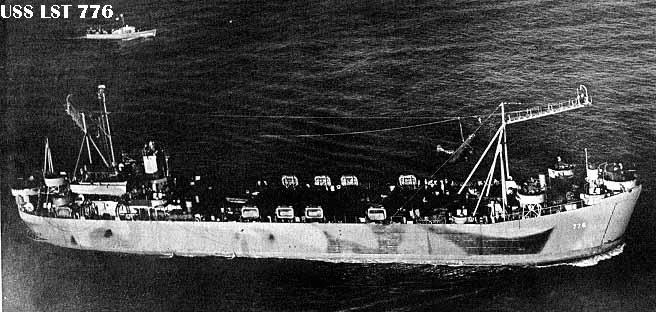
Submarine Aircraft Carriers and F-35 STOVL JSF
Naval Historian Norman Polmar reveals the U.S. Navy funded Boeing studies for an AN-1 and AN-2 submarine aircraft carriers in his recent AIR FORCE magazine article. The Navy and marines are not doing much to win the war on terror and might be interested in a submarine aircraft carrier using the F-35 STOVL and the Boeing JPODS.
To read Polmar's article and read the 1st TSG (A)'s submarine aircraft carrier proposal:
www.combatreform.org/submarineaircraftcarriers.htm
It is increasingly difficult in this telecommunications age to achieve SURPRISE on the non-linear battlefield using huge 6,000 man aircraft carriers. A nation-state military with a surveillance-strike-complex (SSC) can easily detect a large aircraft carrier from air & space. For conflicts against a capable nation-state foe a submarine aircraft carrier will be needed if we want to catch enemies off-guard and actually hit them. Otherwise we will continue to drop millions of dollars of expensive ordnance on nothing but empty mud huts. To defeat SSCs we need a Surveillance Strike MANEUVER capability. Details:
www.geocities.com/strategicmaneuver
Greg Goebel in his excellent web page on Unmanned Aerial Vehicles (UAVs) reveals how Unmanned (Uninhabited) Combat Air Vehicles (UCAVs) are being considered for deployment from trucks and even submarines.
Why is it AOK for small UAVs and UCAVs to be deployed from trucks, submarines etc. but not small MANNED surveillance/attack aircraft?
Proposal:
www.geocities.com/usarmyaviationdigest/fighterinabox.htm
